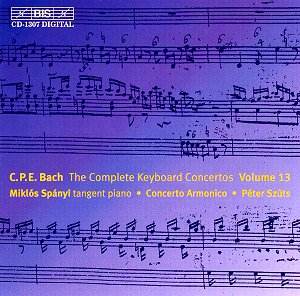Additional CPE Bach recordings by
Miklós Spányi and Péter
Szüts:
Harpsichord Concertos in c, H441; d,
H427; F, H443. Hungaroton HCD 31159
Harpsichord Concertos Volumes 1 - 12:
BIS 707/8, 767/8, 785/6, 857,
867/8, 914, 1097, 1127
This disk is the fourteenth
(!) in a series of the complete keyboard
concerti of this most capable son of
J. S. Bach. In their lifetime the sons
of Bach ó Johann Christian, Carl Philip
Emanuel, and Wilhelm Friedman ó were
considered better composers than their
father who was so irretrievably old-fashioned
and fussy while his sons wrote modern
up-to-date music. In the nineteenth
century their reputations all but disappeared
and they were dismissed as inept imitators
of Mozart ó ironic since Mozart expressed
his debt to them for what they taught
him. One or two works by each were played
over and over and proclaimed to be derivative
and second-rate.
This series has been
an astonishing revelation, and I have
it all [except "volume 11"
but including the first volume which,
oddly, appeared on the Hungaroton label].
Although I had had my own eye-opening
experience many years ago at a live
performance of the great d minor harpsichord
concerto (H.427, W17) by Ingolf Dahl
(cembalo continuo and conductor)
and Ronald Ratcliff (cembalo concertato)
and the University of Southern California
Student Orchestra, I never expected
that experience to be equalled. But
it seems that that transcendent masterpiece
is only one of hundreds of great works
by this tragically (for us) underrated
composer who is only now being discovered
220 years after he died. By 2014, the
three hundredth anniversary year of
his birth, if the rate of discovery
continues, we may be holding rapturous
world-wide celebrations in his honour.
The tangent piano is
a sort of hard hammer fortepiano, one
of the many Eighteenth Century experiments
in keyboard action that eventually led
us to the modern piano.
You arenít about to
buy 14 full price CDs on the off chance
that you might like some of them, but,
as it turns out, this volume by itself
is a good place to start. At this late
date of issue, itís among the best of
the series. Donít be put off by the
title "Sonatina" ó granted,
an odd thing to call a keyboard concerto,
but they are keyboard concerti none
the less, and very good ones. You would
note from looking at the track list
that these works deviate from the fast-slow-fast
pattern of the movements of the Concerti.
The Sonatina in F features the
flute and is one of the finest works
of this composer, well worth owning
on a CD even if it was the only thing
by him ever recorded. The d minor concerto
features horns in the orchestra; the
slow movement has an almost Handelian
grandeur and pathos, while the finale
is pure sturm und drang, a curious
blend of Beethoven and Vivaldi. The
first three movements from the C major
Sonatina, which features both flute
and horns, are also somewhat Handelian,
possibly arias with figurations arranged
from C.P.E. Bachís operas. One of the
very nice things about discovering this
disk ó the thought that there are 13
others yet to be heard.
The program notes to
these many disks constitute an extensive
in-depth essay on the life of the composer,
the instruments, and performance practice
of the time by Spányi and Szüts.
These notes may alone justify the purchase
of the complete set of disks by musicologists
and school libraries.
Paul Shoemaker


